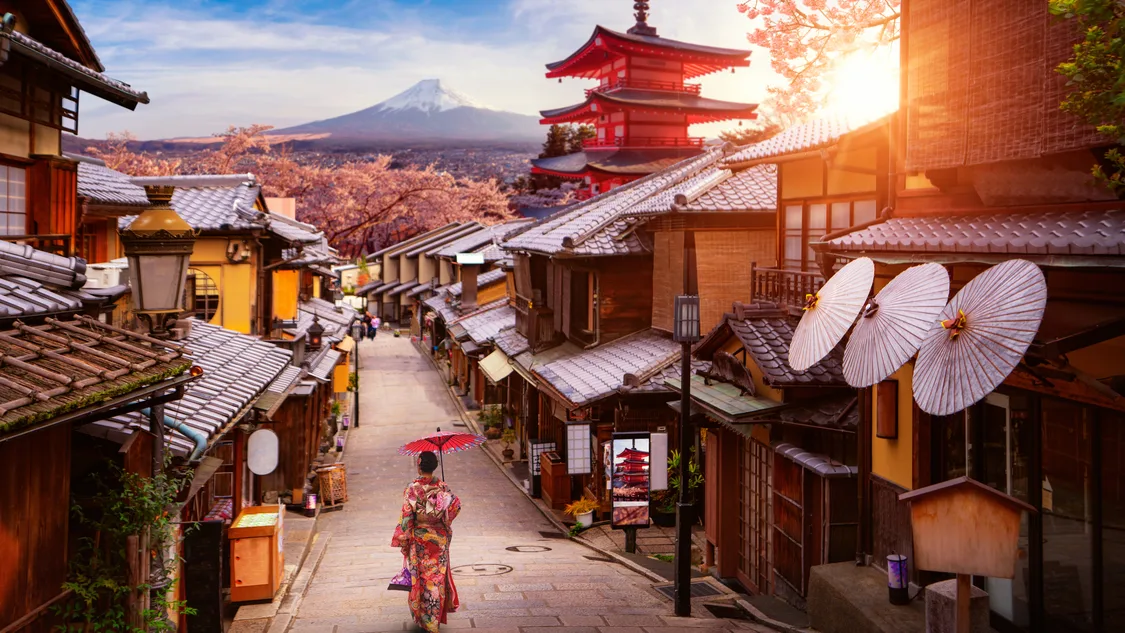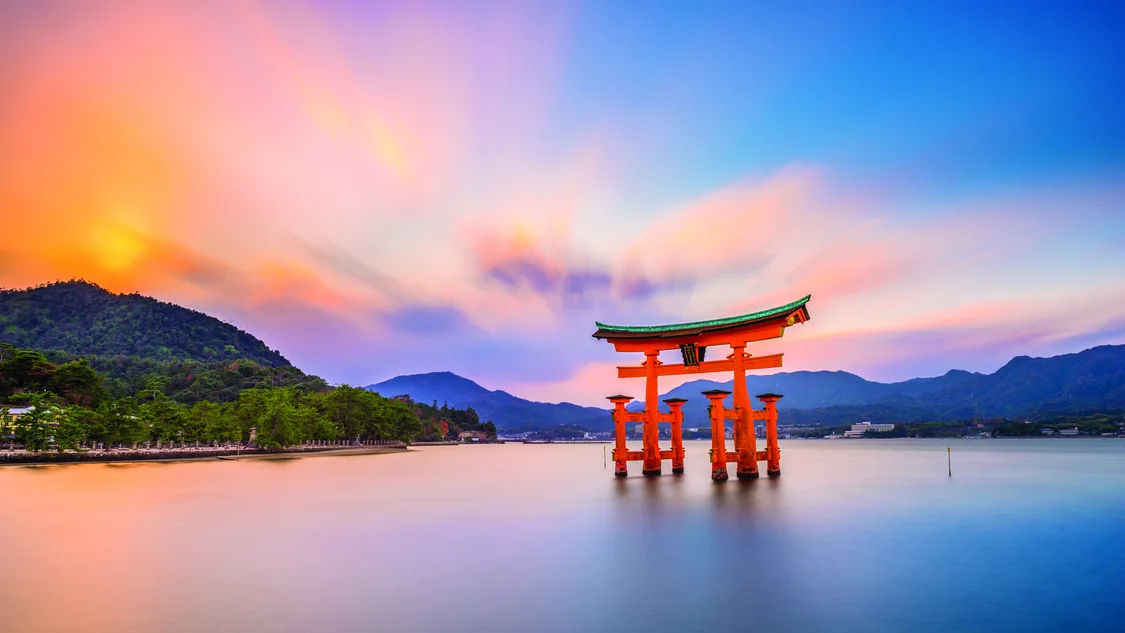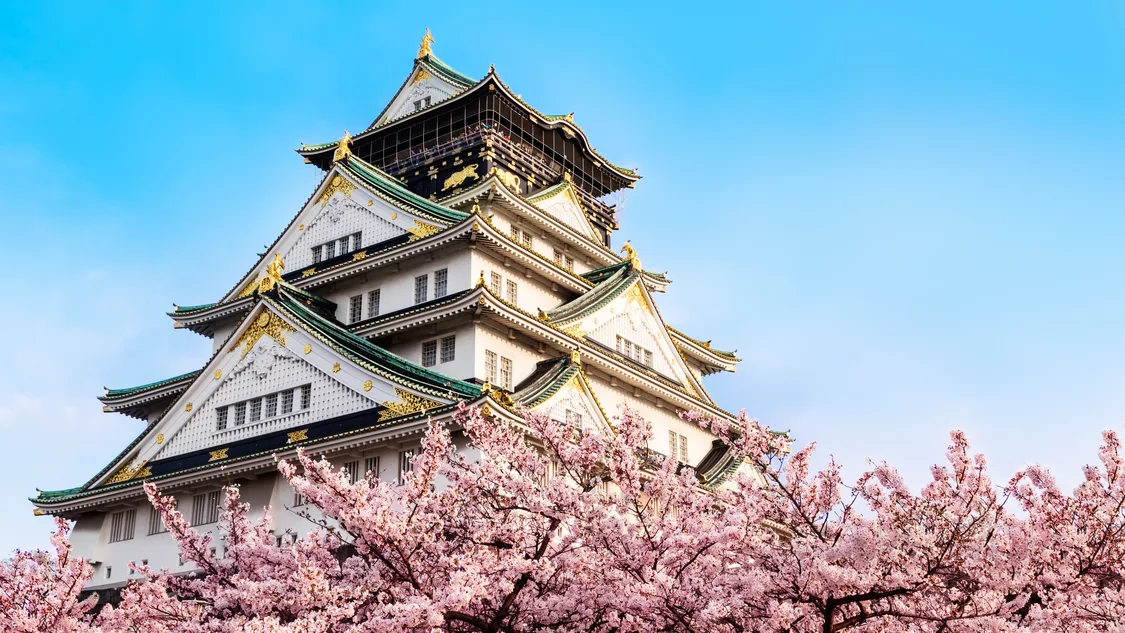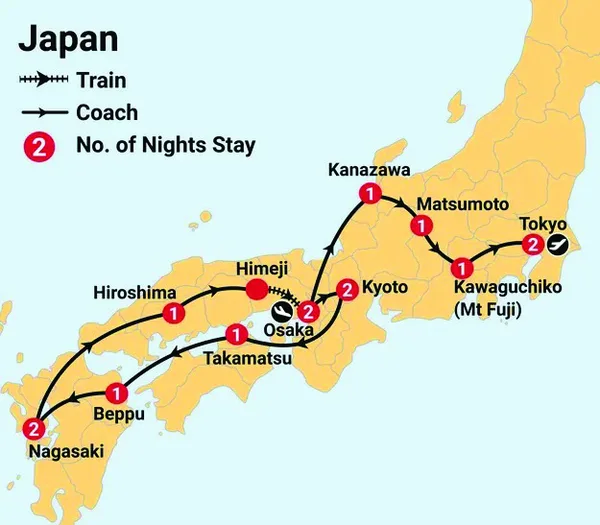Inspiring Japan
15-day small group tour from Osaka visiting sacred shrines, sites & temples – exclusive savings up to $1,360 per couple*



Osaka to Tokyo
15 days / 14 nights
Guided Tour
Multiple departures
Overview
Ride a bullet train, wander through exquisite gardens and visit the sacred shrines, sites and temples Japan is renowned for. From Mount Fuji to charming Kyoto and the buzz of Tokyo, an in-depth look at the real Japan is guaranteed.
*Advertised pricing is based on per person twin share. Pricing may vary depending on departure date. Subject to change & availability at time of booking. Correct as of 25 November 2025.
Highlights & Inclusions
Highlights
- Osaka - Osaka Castle
- Osaka - Dotombori - Shinsaibashi
- Kyoto - Kinkakuji, Heian Jingu, Fushimi Inari
- Kyoto - Arashiyama Bamboo Forest
- Takamatsu - Ritsurin Garden
- Matsuyama - Matsuyama Castle
- Matsuyama - Dogo Onsen
- Beppu - Hells of Beppu
- Nagasaki - Atomic Bomb Museum
- Nagasaki - Dejima
- Nagasaki - Glover Garden
- Hiroshima - Peace Park
- Hiroshima - Atomic Dome
- Miyajima - Itsukushima Shrine
- Himeji - Himeji Castle
- Kanazawa - Kenrokuen Garden
- Kanazawa - Higashi Chaya District
- Shirakawago - Gasho-style Houses
- Takayama - Old Town
- Matsumoto - Matsumoto Castle
- Mount Fuji - 5th Station
- Kawaguchiko - Fuji-san World Heritage Visitor Centre
- Tokyo - Asakusa, Sensoji Temple, Nakamise
- Tokyo - Tokyo Metropolitan Building Observation Deck
- Tokyo - Imperial Palace
- Tokyo - Tsukiji Fish Market
Inclusions
- 14 nights in central 3 and 4-star hotels
- Stay in the heart of Tokyo, Osaka, Hiroshima and Kyoto
- Breakfast daily and 1 dinner
- Dedicated private transportation throughout
- Fully escorted by a dedicated tour leader
- Incredible sightseeing as per itinerary
- Included Japanese bullet train experience
Itinerary
Your journey through this magical land of contrasts begins in Osaka, a vibrant city renowned for its food culture. Known as tenka no daidokoro (the nation’s kitchen), it’s a dream for foodies. Try some of its famed street food like takoyaki (octopus and pickled ginger in batter), kushikatsu (deep-fried meat and vegetable skewers) or Osaka-style okonomiyaki (a delicious savoury pancake).
Day 2 - Osaka - Kyoto
We’ll tour central Osaka today, starting with a tour of the extensive grounds of Osaka Castle, an important historic monument of feudal Japan. It was built in the 16th century by Toyotomi Hideyoshi, one of Japan’s most famous warlords. At the time of completion it was the largest castle in the country. Please note, entry to the Castle keep is not included but you will have time if you would like to enter.
We’ll go to the Namba area and see Shinsaibashi, a shopping district with everything from fast fashion to luxury brands. The flashy district of Dōtonbori is a hive of activity; a shopping, food and entertainment hotspot. You’ll find a host of gastronomic delights here, from Michelin-starred establishments to exciting street food – no surprise given the city’s strong food heritage. With its colourful neon lights and signs, it’s home to one of Osaka’s most photographed icons, the neon Glico running man sign. Dōtonbori Street runs parallel to the eponymous canal and is a great place to pick up souvenirs. Here you will have time to get some of your first Japanese food for lunch.
We’ll head for magical Kyoto and visit Fushimi Inari Shine on arrival. This important Shinto shrine in southern Kyoto was dedicated to Inari, the god of rice and sake, by the Hata clan in the eighth century. A magical path of over 5000 vibrant orange torii gates winds its way through the hills behind the shrine.
A contrast to bustling Osaka, Kyoto showcases the essence of traditional Japanese culture and rich history with its timeless charm. Kyoto is considered by many to be the jewel in Japan’s crown and one of the only cities in Japan to escape destruction during World War II, leaving its countless relics intact.
Perhaps stroll the streets of Gion, Kyoto's most famous geisha district. With any luck you might spot a geisha, otherwise known as a geiko or maiko.
Day 3 - Kyoto
Nearby Heian Jingu Shrine is a relatively young sacred location – built in 1895 – but this Shinto shrine is very impressive, with its enormous torii (sacred gate) standing almost 25 meters high.
We’ll continue onto some of Kyoto’s most iconic sites, like Kinkaku-ji (Golden Pavilion). This is a Zen temple and UNESCO World Heritage Site, with two floors covered entirely in thin layers of pure gold, set within a beautiful classical Zen garden.
We’ll stop for lunch at Arashiyama before a mesmerising experience – standing amongst the soaring stalks of bamboo at Arashiyama Bamboo Grove. It’s green, peaceful and the seemingly endless boughs make for a serene experience, even with the tourist crowds. Take in the sound of rustling bamboo as you stroll these paths – if there’s a bit of wind, the groves will gently sway back and forth which only adds to the magic.
Day 4 - Kyoto - Naruto Strait Takamatsu
Touring the open-air museum of Shikoku Mura is the perfect chance to explore Japan’s history and heritage, with a glimpse of old village life. Over 20 restored traditional buildings and structures, built in the Shikoku style and mainly from the Edo and Meiji periods, were relocated here from all over the island.
This hillside village includes farmhouses, storehouses, production workshops for soy sauce and sugar, a thatched kabuki theatre and a vine suspension bridge made of vine and wood. There is also a small, modern art gallery.
We will also visit the Ritsurin Garden, an exquisite traditional garden. Built during the Edo period – when the city was a castle town controlled by the Matsudaira clan – it’s a National Treasure and arguably one of the most beautiful gardens in the country.
There are six ponds and 13 buildings in this tranquil oasis, including a lush lotus pond and the Okedoi-no-Taki waterfall. Pine-covered Mount Shiun at the garden’s western border provides a gorgeous backdrop. There is also a tea house and various folk art and craft exhibits.
Day 5 - Takamatsu Matsuyama Beppu
At Misaki, we’ll board a ferry to the onsen town of Beppu, known for its spectacular hot springs. It’s on the island of Kyushu, Japan’s third-largest island.
Day 6 - Beppu Nagasaki
Each ‘hell’ is distinctly different. We will be visiting the largest of the seven pools, Umi (Sea) Jigoku which earned its name for its vivid turquoise colour. Fun Fact - the oldest hell Chinoike (Blood Lake) Jigoku is – you guessed it – blood red, a magnificent sight with steam rising from it.
We’ll travel south to Nagasaki, one of two cities in Japan destroyed by an atomic bomb during World War II. Our first stop is a visit to Glover Garden, for an insight into Nagasaki’s cosmopolitan past. This open air museum has six Western-style buildings from all over the city that were relocated here – grand mansions that were once home to Nagasaki’s foreign residents, such as European diplomats and foreign traders. Take in the lovely views over the harbour. Nearby here is Oura Church, said to be the oldest church in Japan. Lunch will be in Nagasaki today, so tuck into some local cuisine.
You’ll arrive at your hotel after a fulfilling day of sightseeing with the rest of your evening at leisure.
Day 7 - Nagasaki
Nagasaki Peace Park is next to the museum, located near the hypocentre of the atomic bomb blast. In the Zone of Hopes, the towering Peace Statue at the back of the park points up to the sky with its right hand and its left arm is horizontal to represent the wish for peace. On either side of the statue are two small shrines draped with origami crane garlands, in memory of Sadako and the Thousand Paper Cranes. There are five zones in this grand park, a serene place for reflection.
We will spend the majority of our morning here before we drive to Dejima Wharf, where we will have lunch at your leisure. This is a waterfront area in Nagasaki. Historically, it served as an artificial island constructed in the 17th century to accommodate foreign traders, primarily Dutch merchants. During Japan's Sakoku (closed-country) period, when the country had limited interactions with the outside world, Dejima was one of the few places where foreign trade was permitted. The Dutch East India Company was the only European entity allowed to conduct trade with Japan during this era, and Dejima was their designated trading post.
The rest of your afternoon is at leisure before an early start tomorrow morning.
Day 8 - Nagasaki - Miyajima Island - Hiroshima
Just offshore we'll spy a 'floating' vermilion torii, which becomes partially submerged at high tide. It marks the entrance to Itsukushima Shrine, which was first built in the 12th century. We’ll tour the shrine, a UNESCO World Heritage Site.
We will then travel onwards for our night in Hiroshima.
Day 9 - Hiroshima Himeji Osaka
The flame in the cenotaph is intended to burn until the last nuclear weapon has been destroyed. The Hiroshima Peace Memorial Museum, located in the Peace Memorial Park, is a sobering experience for those who wish to explore further.
We’ll then travel to the Himeji area where we will make a brief stop for lunch, then continue onto a tour of magnificent Himeji Castle, the largest surviving example of a traditional Japanese castle.
Comprising 83 buildings, the white roof of this UNESCO-listed complex is said to evoke the wings of a heron taking flight, hence the popular name ‘Shirasagi-jō’, meaning White Heron Castle. Himeji Castle is said to be the most visited in Japan, and the site offers some wonderful views of surrounding Himeji city.
To finish off the day, you will Japan’s world-famous bullet train, a shining example of this country’s technology and engineering prowess, is an absolute must-do. We’ll take the shinkansen to Osaka.
Day 10 - Osaka Kanazawa
On arrival, we’ll tour Kenrokuen Garden, heralded as one of the three most beautiful gardens in Japan. Developed over the course of more than 200 years, starting in 1620, the garden contains almost 9000 trees and 200 plant species.
We’ll enjoy a walking tour of the Higashi Chaya District, famous for its well-preserved wooden teahouses where geisha perform.
Day 11 - Kanazawa Matsumoto
Then we’ll head to the city of Takayama, nestled in the Hida mountains. Here, you will enjoy lunch at your own leisure.
This city still retains a traditional feel, especially in its beautifully preserved old merchant district. Here you’ll find quaint, old latticed wooden buildings and Sannomachi Street, with pretty homes, restaurants and sake breweries. Enjoy a walking tour of the old town before travelling to Matsumoto.
Day 12 - Matsumoto Mount Fuji Lake Kawaguchiko
Matsumoto Castle, with its wide moat, is also known as ‘Crow Castle’ due to its dramatic black exterior. The donjon (keep) – Japan’s oldest remaining wooden keep, completed around 1593 – is listed as a National Treasure of Japan. On a clear day, the backdrop of the Japanese Alps is the perfect touch on this majestic setting.
After lunch at one of Japan's high-quality service stops, it’s then about a three-hour journey to the revered peak, Mount Fuji, a UNESCO World Heritage Site. This enduring cultural symbol has been considered sacred since ancient times. It’s an imposing sight, standing 3,776 meters high.
We’ll travel to Mount Fuji 5th Station, about halfway up the mountain, at an elevation of 2,300 meters. You’ll savour spectacular views over the Fuji Five Lakes and Hakone National Park.
You’ll be staying in the Lake Kawaguchiko area. This is the most accessible of the Fuji Five Lakes; popular sightseeing spots for admiring the dramatic peak. Iconic Mount Fuji is notoriously shy, but in clear conditions the views from these spots are stunning. This lake is also home to a cherry blossom festival held during the season, one of the most popular in the country.
Day 13 - Lake Kawaguchiko Tokyo
Following this, enjoy a visit to Itchiku Kubota Art Museum to learn about the revival of the lost art of Tsujigahana silk dyeing for kimonos, thanks to celebrated 20th-century textile artist Kubota Itchiku. This serene complex in the wooded hills, ensconced in nature with extensive gardens and a traditional tea room, is home to a vast collection of the artist’s works.
Then it’s onto Tokyo, famed metropolis, arguably one of the most extraordinary capital cities on the planet. Japan’s eclectic capital is a city of wonder. The Tokyo metropolitan area spreads over three prefectures with 38 million residents.
On the way to our hotel, if conditions are clear, we’ll stop at Tokyo Metropolitan Government Building for late afternoon panoramic city views over this energetic city.
Day 14 - Tokyo
We’ll walk along Nakamise, the shopping street connecting the front gate and main hall of the temple. It’s a wonderful atmosphere, with food stalls and souvenir shops, selling authentic Japanese items like traditional crafts. You’ll find great souvenirs here.
Then, foodies will be in heaven at Tsukiji Outer Market, a shopping district adjacent to the enormous former wholesale fish market. This lively area is home to everything food-related – fresh ingredients, street food vendors, kitchen utensils. There’s great sushi and other restaurants around here, too.
Next, we'll venture into the vibrant neighborhood of Shibuya, allowing you some time to explore at your leisure and discover a delightful local eatery for lunch (at your own expense). You'll have the option to extend your stay in this bustling district or return to the hotel with the group, where the evening will be yours to savor and relish your final moments in Tokyo!
Day 15 - Tokyo
Today marks the end of your spectacular journey through Japan.
At the appropriate time please make your own way to the airport for your flight home or embark on your own independent onward journey.
Booking terms and conditions apply.
We just need some details...
Then one of our expert Consultants will get back to you shortly.

